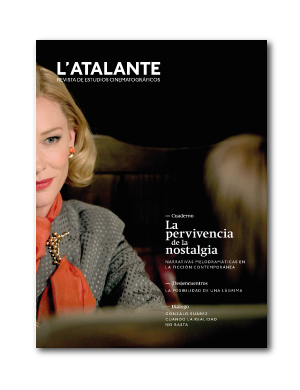Published 2018-01-31
Keywords
- Raúl Ruiz,
- Audibility,
- Sound,
- Cinema,
- Materiality of the voice
How to Cite
Abstract
Through an analysis of three films by Raul Ruiz, Image de sable, Les divisions de la nature and Le film à venir, this article explores the creative practices used by this Chilean filmmaker to construct a mode of cinematic audibility. The common factor of these three films is the way they challenge standard practices in cinematic sound, practices that have been dictated by technological progress, synchronisation and sound quality, and that have given rise to other constants, such as the predominance of the human voice and the spoken word. The article concludes by confirming the feasibility of cinematic audibility, the existence of a soundtrack, the aesthetic richness of the materiality of the voice, the breadth of perception in filmmaking and the need to understand film as an ensemble of images and sound, in which neither of these elements loses its autonomy or uniqueness.
Downloads
References
Bayle, F. (1989). <em>L’image du son, ou i-son. Métaphore/Métaforme</em>. En S. McAdams e I. Deliège (eds.), <em>La musique et les sciences cognitives</em> (pp. 235-242). Bruselas: Editions Mardaga. <br>
Boulez, P. (1963). <em>Penser la musique aujourd’hui</em>. París: Editions Denoël/Gonthier. <br>
Busch, R. (1985). On the Horizontal and Vertical Presentation of Musical Ideas and on Musical Space (I). <em>Tempo, New Series</em>, 154, 2-10. Recuperado de http://www.jstor.org/stable/946351.<br>
Chion, M. (1997). <em>La música en el cine</em>. Barcelona: Grupo Planeta.<br>
— (1982). <em>La musique electroacoustique</em>. París: Presses Universitaires de France. <br>
— (1983). <em>La voix au cinema</em>. París: Editions de l’Etoile.<br>
— (2008). <em>L’audiovision. Son et image au cinéma</em>. París: Armand Colin.<br>
de los Ríos, V. (ed.) (2010). <em>El cine de Raúl Ruiz. Fantasmas, simulacros y artificios. </em>Santiago de Chile: Uqbar editores.<br>
Deshays, D. (2010). <em>Entendre le cinéma</em>. París: Klincksieck.<br>
Larson Guerra, S. (2015). <em>Pensar el sonido. Una introducción a la teoría y la práctica del lenguaje sonoro cinematográfico</em>. México: Universidad Nacional Autónoma de México.<br>
Mouëllic, G. (2014). <em>De quelques performances musicales dans le cinéma contemporain</em>. En S. Abhervé, N. T. Binh y J. Mouré (dirs.), <em>Musiques de films. Nouveaux enjeux</em> (pp. 145-162). Bruselas: Les impressions nouvelles.<br>
Rancière, J. (2000). <em>Le partage du sensible</em>.<em> Esthétique et politique</em>. París: La Fabrique.<br>
Rancière, J. (2011). <em>Aisthesis. Scènes du régime esthétique de l’art</em>. París: Galilée.<br>
Ruiz, R. (2010). <em>Las seis funciones del plano</em>. En V. de los Ríos (ed.), <em>El cine de Raúl Ruiz. Fantasmas, simulacros y artificios </em>(pp. 305-316). Santiago de Chile: Uqbar editores.<br>
— (2013). <em>Ruiz. Entrevistas escogidas – filmografía comentada</em>. Santiago de Chile: Ediciones Universidad Diego Portales. <br>
— (2013b). <em>Poéticas del cine</em>. Santiago de Chile: Ediciones Universidad Diego Portales.<br>
Solomos, M. (2013). <em>De la musique au son. L’émergence du son dans la musique des XX</em>e<em>-XXI</em>e<em> siècles</em>. Rennes: Presses Universitaires de Rennes.<br>
Vera, A. (2013). <em>Políticas de la espectralidad en el cine de Raúl Ruiz: una lectura desde una filosofía de la desaparición</em>. Revista de Humanidades de Valparaíso, 1, 93-101. Recuperado de https://dialnet.unirioja.es/descarga/articulo/5652338.pdf.</p>

